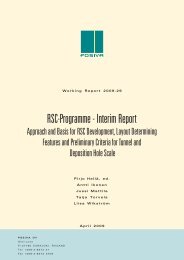Results of Monitoring at Olkiluoto in 2006 - Environment (pdf) - Posiva
Results of Monitoring at Olkiluoto in 2006 - Environment (pdf) - Posiva
Results of Monitoring at Olkiluoto in 2006 - Environment (pdf) - Posiva
Create successful ePaper yourself
Turn your PDF publications into a flip-book with our unique Google optimized e-Paper software.
47908070605040302010010/04/200724/04/200708/05/200722/05/200705/06/200719/06/200703/07/200717/07/200731/07/200714/08/200728/08/2007% <strong>of</strong> biomass11/09/200725/09/2007CyanophyceaeCryptoph.Chrysoph.Prymnesioph.Bacillarioph.Pras<strong>in</strong>oph.MonadsD<strong>in</strong>oph.Figure 35. Vari<strong>at</strong>ion <strong>of</strong> dom<strong>in</strong><strong>at</strong><strong>in</strong>g phytoplankton species by sampl<strong>in</strong>g d<strong>at</strong>e <strong>at</strong> SEA08<strong>in</strong> <strong>2006</strong>. Species with m<strong>in</strong>or shares have been removed for clarity. Figure after Turkki(2007).Due to the fact th<strong>at</strong> the cool<strong>in</strong>g w<strong>at</strong>er discharge area with its surround<strong>in</strong>gs stays openalso dur<strong>in</strong>g the w<strong>in</strong>ter, considerable amounts <strong>of</strong> cool season planktons (Bacillariophyceaeand D<strong>in</strong>ophyceae) grow <strong>in</strong> the w<strong>at</strong>ers even <strong>in</strong> mid-w<strong>in</strong>ter. The abundant spr<strong>in</strong>gtimeproduction <strong>of</strong> Bacillariophyceae therefore usually starts <strong>at</strong> least a month earlierthan <strong>in</strong> other coastal w<strong>at</strong>er areas and the grow<strong>in</strong>g season is longer. The spr<strong>in</strong>gtimesampl<strong>in</strong>g caught the maximum spr<strong>in</strong>gtime bloom <strong>in</strong> <strong>2006</strong>, and the total biomass <strong>in</strong>April-May was considerably gre<strong>at</strong>er than <strong>in</strong> previous years. The average biomass onSEA08 dur<strong>in</strong>g the whole grow<strong>in</strong>g season (1787 mg/m 3 ) was over 2 times th<strong>at</strong> <strong>of</strong> 2005(Fig. 36), and also larger than the 5-year averages from 1985 to 2004. Annual differenceshave been gre<strong>at</strong> s<strong>in</strong>ce 1985 (370-1830 mg/m 3 ). The <strong>in</strong>crease <strong>of</strong> grow<strong>in</strong>g seasonbiomasses have mostly been due to mild w<strong>in</strong>ters (extend<strong>in</strong>g the grow<strong>in</strong>g season) andgeneral eutrophic<strong>at</strong>ion <strong>of</strong> the Baltic Sea.
















